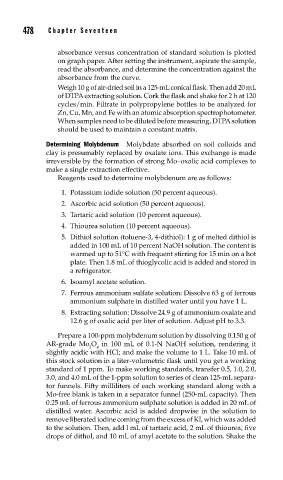Page 506 - Biosystems Engineering
P. 506
478 Cha pte r Se v e ntee n
absorbance versus concentration of standard solution is plotted
on graph paper. After setting the instrument, aspirate the sample,
read the absorbance, and determine the concentration against the
absorbance from the curve.
Weigh 10 g of air-dried soil in a 125-mL conical flask. Then add 20 mL
of DTPA extracting solution. Cork the flask and shake for 2 h at 120
cycles/min. Filtrate in polypropylene bottles to be analyzed for
Zn, Cu, Mn, and Fe with an atomic absorption spectrophotometer.
When samples need to be diluted before measuring, DTPA solution
should be used to maintain a constant matrix.
Determining Molybdenum Molybdate absorbed on soil colloids and
clay is presumably replaced by oxalate ions. This exchange is made
irreversible by the formation of strong Mo–oxalic acid complexes to
make a single extraction effective.
Reagents used to determine molybdenum are as follows:
1. Potassium iodide solution (50 percent aqueous).
2. Ascorbic acid solution (50 percent aqueous).
3. Tartaric acid solution (10 percent aqueous).
4. Thiourea solution (10 percent aqueous).
5. Dithiol solution (toluene-3, 4-dithiol): 1 g of melted dithiol is
added in 100 mL of 10 percent NaOH solution. The content is
warmed up to 51°C with frequent stirring for 15 min on a hot
plate. Then 1.8 mL of thioglycolic acid is added and stored in
a refrigerator.
6. Isoamyl acetate solution.
7. Ferrous ammonium sulfate solution: Dissolve 63 g of ferrous
ammonium sulphate in distilled water until you have 1 L.
8. Extracting solution: Dissolve 24.9 g of ammonium oxalate and
12.6 g of oxalic acid per liter of solution. Adjust pH to 3.3.
Prepare a 100-ppm molybdenum solution by dissolving 0.150 g of
AR-grade Mo O in 100 mL of 0.1-N NaOH solution, rendering it
3 4
slightly acidic with HCl; and make the volume to 1 L. Take 10 mL of
this stock solution in a liter-volumetric flask until you get a working
standard of 1 ppm. To make working standards, transfer 0.5, 1.0, 2.0,
3.0, and 4.0 mL of the 1-ppm solution to series of clean 125-mL separa-
tor funnels. Fifty milliliters of each working standard along with a
Mo-free blank is taken in a separator funnel (250-mL capacity). Then
0.25 mL of ferrous ammonium sulphate solution is added in 20 mL of
distilled water. Ascorbic acid is added dropwise in the solution to
remove liberated iodine coming from the excess of KI, which was added
to the solution. Then, add l mL of tartaric acid, 2 mL of thiourea, five
drops of dithol, and 10 mL of amyl acetate to the solution. Shake the

